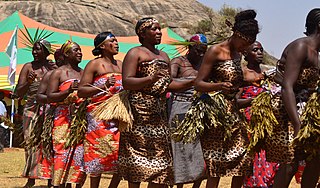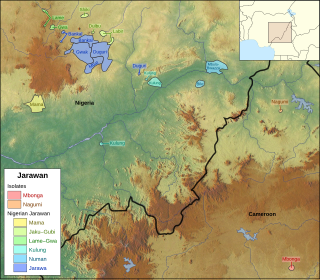Related Research Articles

There are over 525 native languages spoken in Nigeria. The official language and most widely spoken lingua franca is English, which was the language of Colonial Nigeria. Nigerian Pidgin – an English-based creole – is spoken by over 60 million people.
Ga is a Biu-Mandara language spoken by about 43,000 people in the Gombi Local Government Area in Adamawa state of Nigeria. Many speakers live across the length and breadth of Nigeria. It has three dialects, Ga'anda, Gabun and Boga; Blench (2006) classifies Gabun is a separate language.
Mwaghavul is an Afro-Asiatic language spoken in Plateau State in central Nigeria and predominantly in Mangu LGA.
Guduf-Gava is an Afro-Asiatic language spoken in Borno State, Nigeria. In a 2006 paper, Roger Blench classified Cineni as a dialect.

Ron is an Afro-Asiatic language cluster spoken in Plateau State, Nigeria. Dialects include Bokkos, Daffo-Mbar-Butura, Monguna/Manguna (Shagau),. Blench (2006) considers these to be separate languages.
Zeem, or Chaari, is an endangered Chadic dialect cluster of Nigeria, whose speakers are shifting to Hausa. Dyarim is closely related.
Demsa is a Local Government Area of Adamawa State, Nigeria with headquarters located in Demsa. Demsa lies on the Benue River.

Jarawan is a group of languages spoken mostly in Bauchi State, Nigeria, with some also scattered in Plateau State, Taraba State, and Adamawa State in the same country. Two related languages formerly spoken in Cameroon are now extinct but are believed to have belonged to the group. This connection between Nigerian and Cameroonian Jarawan is attributed to Thomas (1925). Whether Jarawan languages are best classified alongside other Bantu languages or among non-Bantu Bantoid languages is a matter of ongoing debate. A number of descriptions and classifications in the early 20th century suggest that they may be historically related to Bantu languages but not necessarily Bantu themselves. Other perspectives based on lexicostatistic modeling and other phylogenetic techniques for language comparison argue instead that Jarawan languages are properly classified alongside Zone A Bantu languages (A31-A40-A60). For classifications based on these more recent studies, see for example Blench (2006), Piron (1997), and Grollemund (2012).
Buru and Angwe constitute a potentially rather divergent Southern Bantoid language spoken in Sardauna LGA, Taraba State of Nigeria.
Jili (Lijili) is a Plateau language of Nigeria. It is one of several languages which go by the ambiguous name Koro.
The Rigwe language, Nkarigwe, is a Plateau language of Nigeria spoken by the Irigwe people mainly found in Bassa Local Government Area of Plateau State.
Bauchi is a cluster of Kainji languages spoken in Rafi, Nigeria LGA, Niger State, Nigeria.
Bile (Bille) is one of the few Bantu languages of Nigeria. They can be found domiciled in Adamawa state below the Benue river opposite the Mbula-Bwazza who speak a related Bantu zone A (A60+40b) language.
Lamang (Laamang) is an Afro-Asiatic language cluster of Nigeria. Blench (2006) classifies the Woga variety as a separate language.
Yangkam (Yankam), or Bashar (Basherawa), is a moribund Plateau language of Nigeria. It is located to the west of Bashar town in Plateau State.
Gwamhi-Wuri (Wurə-Gwamhyə-Mba), or Lyase, is a Kainji language of Nigeria. There are three varieties, which have only slight differences. "Lyase-Ne" means 'mother tongue'.
Kakanda is a Nupoid language of Nigeria. Kakanda is spoken in and around Kupa and Eggan. There are scattered villages stretching from the Niger-Benue confluence to as far as Muregi. There are at least 10,000 people. It is most closely related to Gupa and Kupa, although there are also some similarities with Ebira.
Lere is an extinct Kainji dialect cluster of Nigeria. The ethnic population was cited as 16,000 in 2000, of whom only a few speak the language. A wordlist from the Takaya dialect can be found under External links.
Zora (Izora), or Cokoba (Cokobanci) in Hausa, is a Kainji language of Nigeria.
Kagare (Kwagere) is a Kainji language of Nigeria belonging to the Kamuku language complex. There is partial intelligibility with Cinda, Regi and Səgəmuk (Zubazuba). Kagare is reported by Blench, but is not in Ethnologue or Glottolog.
References
- ↑ Mbula-Bwazza at Ethnologue (18th ed., 2015) (subscription required)
- ↑ Blench, Roger (2019). An Atlas of Nigerian Languages (4th ed.). Cambridge: Kay Williamson Educational Foundation.